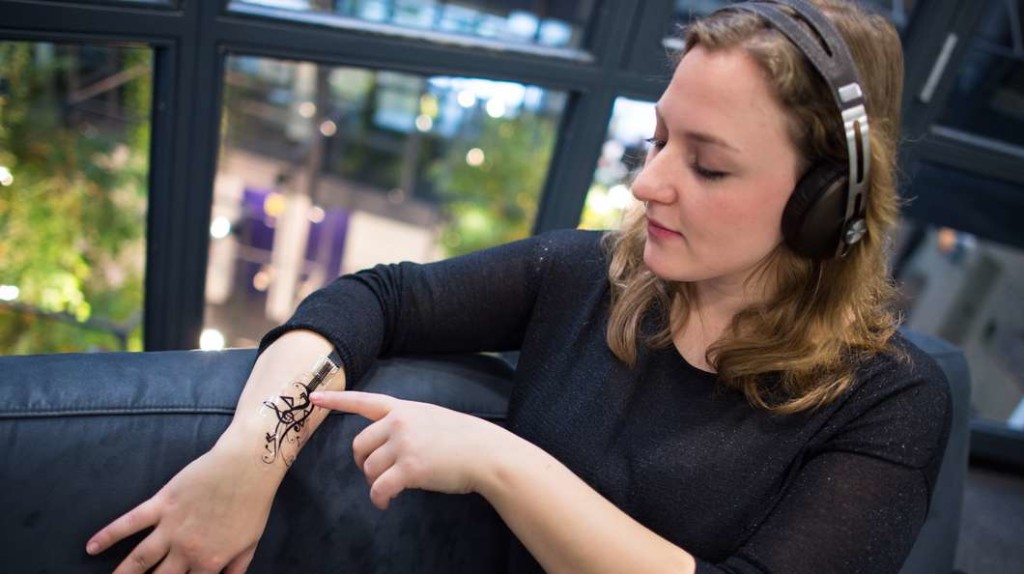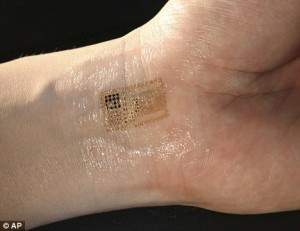iSkin Wearable Tech: Putting Control in the Palm of Your Hand

Wearable technology is everywhere you look these days. Every morning, people strap on their smart glasses, smart watches, wireless bluetooth headsets, and activity trackers to monitor and enhance their daily activities. Wearing a watch or glasses may seem unobtrusive, but imagine if those commands were taken to the next level, where you could turn on a playlist with a snap of your fingers or answer a phone call by simply tapping your ear. A collaborative group of scientists from the Max Planck Institute for Informatics; Saarland University in Saarbrucken, Germany; Carnegie Mellon University; CNRS LTCI/Telecom-ParisTech in Paris, France; and Aalto University in Helsinki, Finland, are now aiming to do just that—with a flexible, silicone-based, skin-mounted system called iSkin.

Researchers sought to enhance the human-computer interactions that have become nearly ubiquitous to everyday life by adapting touch-screen technology and integrating it with a soft, flexible, sensor overlay. The patches are created by sandwiching thin layers of conductive carbon and liquid silicone and tracing them into patterns that resemble tattoos. Current models are hardwired to computers; however, researchers are confident microprocessors could be integrated to create entirely wireless systems.
Wearable technology is nothing new—Chinese mathematicians in the 17th century wore rings with miniature abacuses for quick calculations. Your great grandfather probably even carried a pocket watch. But as access to multiple devices and functions becomes necessary, making these sensors both flexible and stretchable allows for greater ease of use with minimal restriction to user activity.
This innovation in wearable tech stems from research into “electronic skin” initially developed to make prosthetics function more closely to natural limbs by sensing temperature, contact, or pressure. The iSkin prototypes have been used to support single-touch functions or complex inputs such as sliders or click wheels, allowing users to answer phone calls, play music from portable devices, and adjust volume controls.
 While the devices are still in a prototype stage, the implications of this development are staggering. Medical-device manufacturers could utilize this technology to provide less-invasive or less-cumbersome controls for implanted devices such as insulin pumps or pacemakers. The team also believes the technology could be adapted to harvest energy directly from the human body through sources such as temperature or blood flow. Currently the silicone “stickers” are attached with a skin-safe, medical-grade adhesive, but encasing these touch sensors in silicone could mean further evolution from external, wearable technology to implanted, long-term devices that would react to simple gestures and actions.
While the devices are still in a prototype stage, the implications of this development are staggering. Medical-device manufacturers could utilize this technology to provide less-invasive or less-cumbersome controls for implanted devices such as insulin pumps or pacemakers. The team also believes the technology could be adapted to harvest energy directly from the human body through sources such as temperature or blood flow. Currently the silicone “stickers” are attached with a skin-safe, medical-grade adhesive, but encasing these touch sensors in silicone could mean further evolution from external, wearable technology to implanted, long-term devices that would react to simple gestures and actions.
The iSkin development team has stated that there are no plans to further develop the prototype, but they are encouraging others to pick up where they have left off, leaving the door open for a wide variety of applications limited only by the imagination of future developers.
Are you ready to use these wearable tech tattoos? What device would you use with your iSkin? Tell us in the comments!
